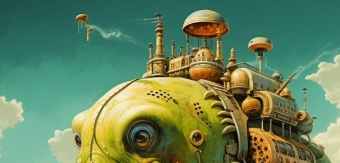London, June 1982. The film director Ridley Scott has hired the Empire Leicester Square and invited hundreds of London's creative people to attend a special lunchtime viewing on his new movie Blade Runner. It's an occasion that has London's ad world buzzing. All the top creative talent of the day are present and the cinema is packed to the rafters. In fact many art directors, copywriters and agency producers have to sit in the aisles.
What the creative people saw that lunchtime left a big impression. Blade Runner was filmmaking at its best. Ridley Scott had taken science fiction and stretched it to its fullest potential, both in terms of storytelling and as an intellectual experience. But the real talking point was the work of Syd Mead - the designer who created the Blade Runner look. He had taken every kind of architectural style available and overlaid them all to create a particularly grimy vision of the future.
Meade's urban landscape was a million miles away from the typical Hollywood sci-fi flick. It was overpowering and dark but amongst the apocalyptic background there were visual gems such as gigantic billboard hoardings, flying vehicles named 'spinners' and Voight-Kampff machines that measured respiration, heart rate and eye movement. Advertising creatives went on to call it cyberpunk and soon it would be used to provide post-apocalyptic chic to everything from car ads to fizzy drinks.
Ridley Scott had never met Mead prior to working on Blade Runner. He was chosen thanks to a book he'd recently had published. 'Ridley had his London staff round up available books by 'futurists' and sci-fi illustrators. My first book, Sentinel had just been published by an English publishing group. That was the link. Ridley specifically liked one rainy, mega-structure city expressway view, and when he came to Los Angeles to start the film, called me, we had a meeting and I was hired on the spot. He had a very definite vision of how he wanted the film to look from the start.
'I had been doing major corporate design work and elaborate illustration for over twenty years by the time I got Blade Runner. Ridley appreciated my grasp of lighting, scenario depiction and the fact that I was completely sympathetic to the aesthetics of the story and his visual skill at interpreting the story into cinema. Ridley accepted my design ideas on the first or certainly the second submission."
Mead says that working with Ridley Scott was a very rewarding experience. 'Ridley only sleeps about four hours a night when he's on a film. He would produce these continuous line sketches for street scenes, and set ideas. The Spinner, Taxi, Sebastian Van were totally mine.â€
How did he feel about the finished production of the movie? Were you happy with the over all look? Mead answers, 'I didn't 'get' the story at all...I had been seeing dailies during the movie's extended pre and production run...I didn't really enjoy the movie as a sequential story event until about the third time I saw it.
It seems the story of Blade Runner is not quite over. Stories of a sequel are now all over the internet and while Sir Ridley Scott has said that he would be interested in shooting a follow-up screenwriter Travis Wright has also revealed he is writing a new script. Watch this space.
http://bladerunnerthemovie.warnerbros.com/



